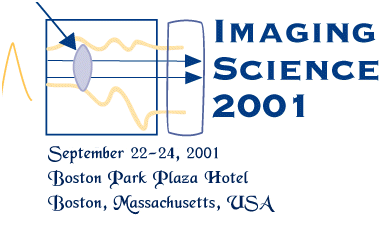

Sponsored by SIAM Activity Group on Imaging Science
Held jointly for the first time with the
First SIAM Conference on the Life Sciences
September 24-26, 2001
Current developments in the technology of imaging have led to an explosive growth in the interdisciplinary field of imaging science. With the advent of new devices capable of seeing objects and structures not previously imagined, the reach of science and medicine have been extended in a multitude of different ways. The impact of this technology has been to generate new challenges associated with the problems of formation, acquisition, compression, transmission, and analysis of images. By their very nature, these challenges cut across the disciplines of physics, engineering, mathematics, biology, medicine, and statistics. While the primary purpose of this conference is to focus on mathematical issues, the biomedical aspects of imaging will also play an important role.
This conference represents the first official function organized by the newly formed SIAM Activity Group on Imaging Science (SIAG/IS). This SIAG and the SIAG on the Life Sciences were both created in recognition of the fact that the mathematics community should participate more directly in these non-traditional areas. Since these two activity groups have such a strong overlap in the area of biomedical imaging, this conference has been scheduled to overlap with the Conference on the Life Sciences, chaired by James Collins, set for September 24-26, 2001.
David C. Wilson (Chair), University of Florida, USA
Akram Aldroubi, Vanderbilt University, USA
Fred Bookstein, University of Michigan, Ann Arbor, USA
Tony Chan, University of California at Los Angeles, USA
Longin Jan Latecki, University of Hamburg, Germany
Chris Johnson, University of Utah, USA
Bernard Mair, University of Florida, USA
Robert J. Plemmons, Wake Forrest University, USA
Gerhard Ritter, University of Florida, USA
Guillermo Sapiro, University of Minnesota, USA
Michael Unser, ETH, Switzerland
SIAM and the Conference Organizing Committee wish to extend their thanks and appreciation to the Army Research Office (AR0) and the Office of Naval Research (ONR) for their support of this conference.
SIAM and the Conference Organizing Committee are proud to announce that the following mathematicians and scientists have accepted their invitations to speak at the conference. These invited speakers and their presentations will play an important role in increasing interaction among mathematicians, engineers, physicists, and researchers and scientists in academia, industry, and government who attend the meeting.
Deadline for submission has passed.
Minisymposia
A minisymposium is a two-hour session consisting of four presentations on a well-focused topic. A number of minisymposia have been solicited by the conference Organizing Committee to supplement the conference themes. The Organizing Committee also encourages proposals for minisymposia in areas related to the conference themes.
Prospective minisymposium organizers are asked to submit a proposal consisting of a title, a description (not to exceed 100 words), and a list of speakers and titles of their presentations using the Conference Management System available at:
http://www.siam.org/meetings/is01/part.htm
Minisymposium organizers should consider the following recommendations when designing their sessions.
The Organizing Committee will review contributed minisymposia and reserve the right to limit the number of minisymposia to maintain an acceptable level of parallelism in the meeting sessions.
Deadline for submission of minisymposium proposals is: March 2, 2001
Contributed Presentations in Lecture Format
Contributed presentations in lecture format are invited in all areas of imaging science consistent with the conference themes. A lecture format involves a 15-minute oral presentation with an additional five minutes for discussion.
Contributed Presentations in Poster Format
A poster presentation consists of the use of visual aides on a 4' x 6' poster board presented in a two-hour informal session that allows presenters to discuss their research with attendees.
Posters should state the subjects, methods, present data, and conclusions.
A poster board will be provided at the conference for each poster presenter.
To know more about a poster presentation please visit:
http://www.siam.org/siamnews/general/poster.htm
http://www.siam.org/meetings/guidhome.htm
The Organizing Committee reserves the right to limit the number of contributed presentations a single speaker may present.
Deadline for submission of contributed abstracts for a lecture or poster: April 6, 2001.
![]() Conference Speakers
Conference Speakers
The Conference organizing committee expects every speaker of a scheduled presentation to register and attend the conference. (SIAM would ask that the speaker(s) pre-register so that all program materials are ready for the speaker(s) when they arrive and check in at the registration desk).
If it becomes necessary for a speaker to cancel his/her presentation, the speaker is expected to find an alternate presenter immediately, preferably one of the speaker's co-authors. The speaker must inform the SIAM Conference Department immediately of any change to his/her scheduled presentation.
A 'no-show' or cancelled presentation can cause serious inconvenience to the attendees and conference organizers.The committee thanks all speakers in advance for compliance with this request.
Every presenter of a contributed or poster presentation must submit a 75-word abstract, which must be sent electronically using the Conference Management System available at: http://www.siam.org/meetings/is01/part.htm. The 75-word abstract will appear in the final program.
Boston Park Plaza Hotel
Boston, Massachusetts, USA 02116
Phone:
(617) 426-2000
Built in 1927, the venerable Boston Park Plaza maintains the luxury and splendor that has attracted heads of state, famous stars, and anyone who cherishes the grand era of American hotels. It is conveniently located in the heart of historic Back Bay, adjacent to Boston Common and the Public Garden.
For information on the Boston area, visit http://www.bostonusa.com/visitor/visitor.php.
The purpose of the SIAM Activity Group on Imaging Science is to:
The SIAG brings together researchers who seek to develop and apply mathematical and computational methods in all areas of imaging science. It cuts across disciplines to catalyze mathematical research relevant to imaging science and rapid diffusion of advances in mathematical and computational methods.
© 2001 Society for Industrial and Applied Mathematics
Designed by Donaghy's Web Consulting
Created 10/25/00; Last Updated 6/10/01